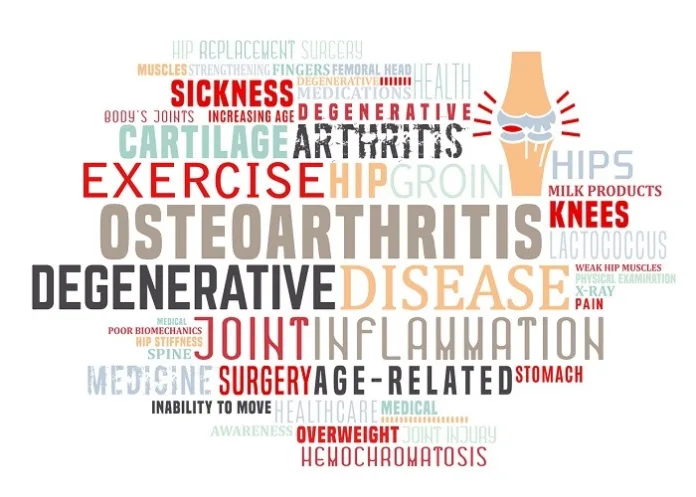Researchers have estimated that by 2050, osteoarthritis – which affects 15% of the global population over 30 – will have affected nearly 1bn people, and that more women than men will continue to grapple with the disease.
Obesity, a major contributor to osteoarthritis, was responsible for 20% of the disability of osteoarthritis in 2020, a condition which causes joints to become painful and stiff, and which increases with age.
The Independent reports that international research found that for those aged 70 and older, it ranked seventh among causes for years lived with disability (YLDs).
The research, published in The Lancet Rheumatology, analysed 30 years of osteoarthritis data (1990–2020) covering more than 200 countries.
It was led by the Institute for Health Metrics and Evaluation (IHME) as part of the Global Burden of Disease Study 2021.
The findings showed cases have increased rapidly over the past three decades because of ageing, population growth, and obesity.
In 1990, 256m people had osteoarthritis. By 2020, this rose to 595m people – a 132% increase.
By 2050, experts project this figure to reach the 1bn mark.
Dr Jaimie Steinmetz, the paper’s corresponding author and lead research scientist at the IHME, said: “With the key drivers of people living longer and a growing world population, we need to anticipate stress on health systems in most countries.
“There is no effective cure for osteoarthritis right now, so it’s critical to focus on strategies of prevention, early intervention, and making expensive, effective treatments like joint replacements more affordable in low and middle-income countries.”
The knees and hips are the most common areas for osteoarthritis, and by 2050, the condition is projected to increase by 74.9% in the knees, 48.6% in the hand, 78.6% in the hips, and 95.1% in other areas like the elbows and shoulders.
It is also estimated that more women than men will continue to grapple with the condition.
In 2020, 61% of osteoarthritis cases were in women versus 39% in men.
Study details
Global, regional, and national burden of osteoarthritis, 1990–2020 and projections to 2050: a systematic analysis for the Global Burden of Disease Study 2021
GBD 2021 Osteoarthritis Collaborators
Published in The Lancet Rheumatology in September 2023
Summary
Background
Osteoarthritis is the most common form of arthritis in adults, characterised by chronic pain and loss of mobility. Osteoarthritis most frequently occurs after 40 and prevalence increases steeply with age. WHO has designated 2021–30 the decade of healthy ageing, which highlights the need to address diseases such as osteoarthritis, which strongly affect functional ability and quality of life. Osteoarthritis can coexist with, and negatively effect, other chronic conditions. Here we estimate the burden of hand, hip, knee, and other sites of osteoarthritis across geographies, age, sex, and time, with forecasts of prevalence to 2050.
Methods
In this systematic analysis for the Global Burden of Disease Study, osteoarthritis prevalence in 204 countries and territories from 1990 to 2020 was estimated using data from population-based surveys from 26 countries for knee osteoarthritis, 23 countries for hip osteoarthritis, 42 countries for hand osteoarthritis, and US insurance claims for all of the osteoarthritis sites, including the other types of osteoarthritis category. The reference case definition was symptomatic, radiographically confirmed osteoarthritis. Studies using alternative definitions from the reference case definition (for example self-reported osteoarthritis) were adjusted to reference using regression models. Osteoarthritis severity distribution was obtained from a pooled meta-analysis of sources using the Western Ontario and McMaster Universities Arthritis Index. Final prevalence estimates were multiplied by disability weights to calculate years lived with disability (YLDs). Prevalence was forecast to 2050 using a mixed-effects model.
Findings
Globally, 595m (95% uncertainty interval 535–656) people had osteoarthritis in 2020, equal to 7·6% (95% UI 6·8–8·4) of the global population, and an increase of 132·2% (130·3–134·1) in total cases since 1990. Compared with 2020, cases of osteoarthritis are projected to increase 74·9% (59·4–89·9) for knee, 48·6% (35·9–67·1) for hand, 78·6% (57·7–105·3) for hip, and 95·1% (68·1–135·0) for other types of osteoarthritis by 2050. The global age-standardised rate of YLDs for total osteoarthritis was 255·0 YLDs (119·7–557·2) per 100 000 in 2020, a 9·5% (8·6–10·1) increase from 1990 (233·0 YLDs per 100 000, 109·3–510·8). For adults aged 70 years and older, osteoarthritis was the seventh ranked cause of YLDs. Age-standardised prevalence in 2020 was more than 5·5% in all world regions, ranging from 5677·4 (5029·8–6318·1) per 100 000 in southeast Asia to 8632·7 (7852·0–9469·1) per 100 000 in high-income Asia Pacific. Knee was the most common site for osteoarthritis. High BMI contributed to 20·4% (95% UI –1·7 to 36·6) of osteoarthritis. Potentially modifiable risk factors for osteoarthritis such as recreational injury prevention and occupational hazards have not yet been explored in GBD modelling.
Interpretation
Age-standardised YLDs attributable to osteoarthritis are continuing to rise and will lead to substantial increases in case numbers because of population growth and ageing, and because there is no effective cure for osteoarthritis. The demand on health systems for care of patients with osteoarthritis, including joint replacements, which are highly effective for late stage osteoarthritis in hips and knees, will rise in all regions, but might be out of reach and lead to further health inequity for individuals and countries unable to afford them. Much more can and should be done to prevent people getting to that late stage.
See more from MedicalBrief archives:
Why knee joint injury leads to osteoarthritis
Pain management in inflammatory arthritis and osteoarthritis
No link between physical activity and knee osteoarthritis — Meta-analysis
Fish oil may reduce pain in osteoarthritis – UK meta-analysis

